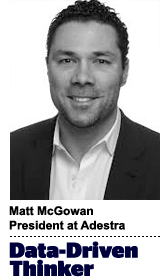 “Data-Driven Thinking” is written by members of the media community and contains fresh ideas on the digital revolution in media.
“Data-Driven Thinking” is written by members of the media community and contains fresh ideas on the digital revolution in media.
Today’s column is written by Matt McGowan, president at Adestra.
Facebook’s move to shut down its Partner Categories program helps it look good in the court of public opinion, shores up some loose ends with respect to the General Data Protection Regulation (GDPR) and possibly drives more profitability for the business as it removes partners that were sharing in the ad buy dollars.
Will the sunsetting of the Partner Categories program be a game-changer for companies that have long relied on a combination of first-party and third-party data to make their advertising more effective?
There really is no quick answer. For one, in my experience, third-party data was often overpriced, old and stale. Moreover, match rates between data providers and advertisers were often overstated. So it was not a very successful method to reduce waste and target more effectively.
That said, from a reporting perspective it offered considerable value, especially when advertisers wanted to know if their buy was on target or not or if the consumers they were reaching were in-market or not.
Without access to this data, targeting will be limited mostly to advertisers’ first-party data sets, in addition to context and demographics, which can still be provided by Facebook. For email marketers, the data they hold dearest – customers’ email addresses – will still be useful: Facebook Custom Audiences isn’t going anywhere and may become increasingly important within the Facebook and larger digital advertising ecosystems.
The real challenge comes with measurement. The third-party data sources behind Facebook also contribute data on campaign effectiveness, since they allow brands to tie Facebook ads to offline behavior and the bottom line. Many advertisers rely on this data integration to calculate ROI. Without it, they can’t be sure their ads are effective, especially if the campaigns are focused on branding and not last-click attribution.
My guess is that brand advertising on Facebook will take a short-term hit. As Facebook rolls this out over the next six months, marketers will have time to rejigger their ad budgets. One potential change could be more spending on Google, a pioneer in targeting on purchase intent.
Facebook also reportedly is developing a new tool that will ask marketers to certify that the email addresses and other first-party data they upload for Custom Audiences have proper user consent. It will be interesting to see how this rolls out in practicality and application.
Permission is key in the online relationship. What is going to be critical is to understand how Facebook defines permission. Is it inferred, implied or explicit? Beyond that, what is the permission granted for? That’s one of the substantial elements of the GDPR – it is not only permission that matters, but permission for the type of use, and this poses a whole range of challenges for marketers to comply with.
De facto GDPR
GDPR, taking effect in May, provides for penalties for use of consumer data without permission. Most companies will implement the requirements across their businesses – not just in the EU.
So consumers around the globe will likely benefit from the privacy and transparency provided by those regulations. But there’s one big difference: Companies operating in Europe will face fines for violating GDPR; in the United States, I predict the fallout will be in their stock price.
Return to best practices
With all this said, marketers should renew their focus on customer retention and loyalty, and I am not just talking about retargeting. Customer retention tools, including personalization, automation and journeys, will remain the most important metric for marketers this year and into the future because increasing retention increases profitability.
At the same time, targeting existing customers and their lookalikes on Facebook will remain more affordable than acquisition campaigns. To make the most of customer data – on Facebook or other channels – marketers’ loyalty programs should be integrated into their own CRM databases and available across all marketing channels.
Now is the time to double down on making the most of first-party data while Facebook sorts itself out.
What’s to come? Maybe one day one of these “social networks” will decentralize itself into a tokenized protocol or true peer-to-peer network.
Follow Adestra (@Adestra) and AdExchanger (@adexchanger) on Twitter.
This post was syndicated from Ad Exchanger.

More Stories
GroupM agencies earn GenderTick accreditation in New Zealand
Doordash Jumps on the Dance Ad Trend, but Makes it ‘Cinematically Weird’
Big and little buddies pay it forward